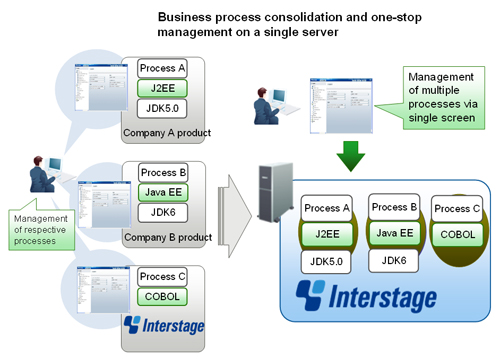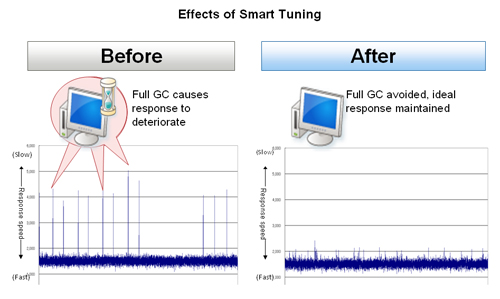Archived content
NOTE: this is an archived page and the content is likely to be out of date.
Fujitsu Releases Interstage Application Server v10
Optimized for consolidating work on private clouds; aggregates and executes multiple generations of Java, COBOL, and C applications on a single application server
Fujitsu Limited
Tokyo, August 18, 2011
Fujitsu today announced the immediate availability of Interstage Application Server v10, the latest version of its application server that is ideally suited for consolidating work on private clouds.
Interstage Application Server v10 is the world's only application server product that can simultaneously aggregate and execute multiple applications developed in different programming languages, including Java EE, J2EE, COBOL, and C, on a single application server. This makes it possible to consolidate, without upgrades, multiple generations of a company's business applications, and thereby makes the software ideal for business consolidation on private clouds—leading to reductions in development and operating costs. In addition, new functionality has been added that completely eliminates the effects of Full GC(1), a major factor behind poor responsiveness in Java applications when consolidating business processes to provide a uniform and stable response. Fujitsu can offer these capabilities by leveraging its proprietary smart technologies.
In addition, based on this product, Fujitsu is offering "Interstage Application Server v1 powered by Windows Azure," an application server that can be employed in a public cloud environment.
Fujitsu's proprietary smart technology autonomously determines the status of hardware and software and optimizes to enhance convenience and reliability. Now, in addition to simplifying business process consolidation, the smart technology-enabled Interstage Application Server v10 halts the deterioration of Java application response and uses Smart Tuning for application stability. Furthermore, to simplify the setting of essential parameters when deploying equipment, the set-up function has been strengthened. This is among the examples of how Fujitsu is using its smart technology to realize greater convenience and reliability.
By building products that incorporate smart technology based on the underlying technologies cultivated in its mainframes, Fujitsu has established itself as an industry leader. The company will offer full-scale support for customers' businesses and provide them with worry-free ICT.
Key Features of Interstage Application Server v10
1. Simplifying business process consolidation, including with existing assets, for private clouds
Customers can consolidate their existing business applications onto a single application server without revisions, making it possible for multiple processes to be managed from a single screen. This enables reductions to application development and operating costs.
- Consolidating multiple Java generations on a single application server: With this product, it is possible to simultaneously execute on a single application server and link together applications developed in completely different programming languages, including the JavaEE and J2EE generations of Java, COBOL, and C.
- Consolidating legacy assets from other application servers: Fujitsu provides migration templates that enable the consolidation of standard-specification applications, as well as orphaned applications from other companies that feature non-standard specifications.
 Business process consolidation and one-stop management on a single server
Business process consolidation and one-stop management on a single server
Larger View (234 KB)
2. Smart Tuning eliminates the need for responsiveness tuning in applications
Smart Tuning monitors applications for warning signs of Full GC, while autonomously controlling input flow to completely eliminate poor responsiveness due to the impact of Full GC. Because the product stabilizes the responsiveness of applications on its own, there is no need, as in the past, for coding complex response stabilization processes into applications and for meticulous memory tuning.
- Warning-sign monitoring: By monitoring the memory utilization history and GC status of Java VMs(2), this feature autonomously determines and detects signs of Full GC and signs associated with slow responsiveness and other problems.
- Input flow control: While monitoring for warning signs and suppressing requests to the affected processes, this feature guarantees that applications are responsive by running them in separate Java VMs. After a Full GC process is complete, the Java VM can accept requests again. This prevents other Java applications and non-Java applications from being affected.
Standard Pricing and Availability
Standard Pricing and Availability
| Product |
Standard Pricing
(Excluding Tax) |
Availability |
| Interstage Application Server Enterprise Edition v10 |
From 2,800,000 yen |
Available now |
| Interstage Application Server Standard-J Edition v10 |
From 550,000 yen |
| Interstage Studio v10 |
From 360,000 yen |
| Interstage Business Application Server Standard Edition v10 |
From 4,800,000 yen |
OS Environment
OS Environment
| |
OS |
| Server |
Microsoft Windows Server 2008 R2
Microsoft Windows Server 2008
Microsoft Windows Server 2003 R2
Microsoft Windows Server 2003
Red Hat Enterprise Linux 6
Red Hat Enterprise Linux 5
Solaris 10
Solaris 9 |
Client
(Development Use) |
Windows 7
Windows Vista
Windows XP |
About Fujitsu
Fujitsu is the leading Japanese information and communication technology (ICT) company offering a full range of technology products, solutions and services. Over 170,000 Fujitsu people support customers in more than 100 countries. We use our experience and the power of ICT to shape the future of society with our customers. Fujitsu Limited (TSE:6702) reported consolidated revenues of 4.5 trillion yen (US$55 billion) for the fiscal year ended March 31, 2011. For more information, please see http://www.fujitsu.com
Press Contacts
Public and Investor Relations Division
Inquiries
Company:Fujitsu Limited
Date: 18 August, 2011
City: Tokyo
Company:
Fujitsu Limited,
,
,
,
,
,
,
,
,
,

